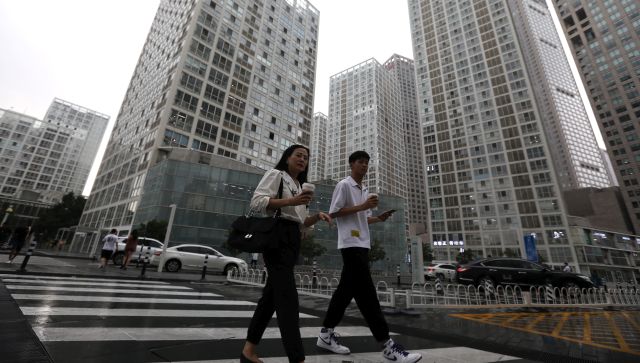Youth unemployment is through the roof in China. New data from China’s National Bureau of Statistics show that youth unemployment has hit 21.3 per cent – a record high and the third straight month over 20 per cent. This, as urban unemployment stayed at 5.2 per cent. But why did this happen? And what does this say about China’s economy? Let’s take a closer look: Why did this happen? According to Goldman Sachs Research, one reason for this is seemingly the disparity between what young people are studying and the available jobs. In the report, Goldman Sachs economist Maggie Wei argued that youth bear the brunt of economic slumps – likely due to their lack of work experience. “That vulnerability may have been amplified by the pandemic, which was tough on service industries that tend to hire more young workers. And while the output gap (the difference between what an economy is producing and what it’s capable of producing) in the services sector narrowed materially in the first quarter of this year, the related increase in demand for workers probably won’t be enough to offset a pending flood of graduates,” the report stated. Gross domestic product grew just 0.8 per cent in April-June from the previous quarter, on a seasonally adjusted basis, data released by the National Bureau of Statistics showed. On a year-on-year basis, GDP expanded 6.3 per cent in the second quarter, accelerating from 4.5 per cent in the first three months of the year, but the rate was well below the forecast for growth of 7.3 per cent.
The latest data raises the risk of China missing its modest 5 per cent growth target for 2023, some economists say.
More timely June data, which was released alongside the GDP numbers, showed China’s retail sales grew 3.1%, slowing sharply from a 12.7% jump in May. Analysts had expected growth of 3.2%. Industrial output growth unexpectedly quickened to 4.4% last month from 3.5% seen in May, but demand remains lukewarm. Private fixed-asset investment shrank 0.2% in the first six months, a sharp contrast to the 8.1% growth in investment by state entities, suggesting weak private business confidence. What does this mean? Despite China’s NBS claiming that the economy “showed good momentum of recovery in the first half year”, experts say data show it is struggling and growth is weak. Qian Wang, Asia Pacific chief economist at Vanguard, told the BBC, “The disappointment is particularly evident in retail sales and housing investment.” “This, coupled with earlier trade, inflation and credit reports, reaffirmed our view that the underlying growth momentum is still very weak,” she added. Business Insider quoted Vishnu Varathan, the head of economics and strategy at Mizuho Bank, as writing that growth has slowed. “Once base effect distortions are backed out, China’s economy remains dismal,” he added. “It is clear that growth momentum has been fading rapidly,” economists from Nomura wrote, as per Insider.
“The data suggests that China’s post-COVID boom is clearly over,” said Carol Kong, economist at Commonwealth Bank of Australia in Sydney.
“The higher-frequency indicators are up from May’s numbers, but still paint a picture of a bleak and faltering recovery and at the same time youth unemployment is hitting record highs.” What happens next? Things are likely to get worse before they get better. “Addressing the misalignment between school disciplines and business demand would help, but this is a difficult and medium-term task and unlikely to yield significant improvement in the short run,” Goldman Sachs economists suggested. Bloomberg quoted NBS spokesman Fu Linghui as saying the July number would likely be even higher. Fu said this is because youth are wrapping up their education and searching for jobs. Beijing says around 12 million students – a record – are expected to graduate this year. Fu said Beijing is focusing on youth employment and is making efforts to put young people in a “more prominent position” – particularly on recent graduates and those starting their own businesses. Fu added that China needs to make efforts to “stabilise” the situation and that the rate will likely begin declining post-August. Dan Wang, chief economist at China’s Hang Seng Bank, told BBC that though unemployed youth comprise just 1.4 per cent of the potential workforce in urban areas, Beijing needs to take things seriously.
This “demands more direct policy responses, because this group of the population is quite vocal online,” Wang told BBC.
“Their expression of discontent of the current situation may trigger a wider loss of confidence in the economy,” she added. Experts also told BBC this increases chances of Beijing announcing actions that give the economy a shot in the arm. Authorities are likely to roll out more stimulus steps including fiscal spending to fund big-ticket infrastructure projects, more support for consumers and private firms, and some property policy easing, policy insiders and economists said. But a quick turnaround is unlikely, analysts say. Chinese authorities also face a daunting task in trying to keep the economic recovery on track and putting a lid on unemployment, as any aggressive stimulus could fuel debt risks and structural distortions. All eyes are on an expected Politburo meeting later this month, when top leaders could chart the policy course for the rest of the year. A few economists have flagged the risk of a balance sheet recession, as Chinese households and private firms build up savings and reduce borrowing and spending after three years of COVID curbs. “We expect to see monetary policy easing in coming months and targeted fiscal supports given to key industries, including real estate and construction,” Harry Murphy Cruise, economist at Moody’s Analytics, said in a note. “But that extra support won’t be a silver bullet. Increasingly, 2023 is looking like a year to forget for China.” With inputs from agencies


)

)
)
)
)
)
)
)
)



